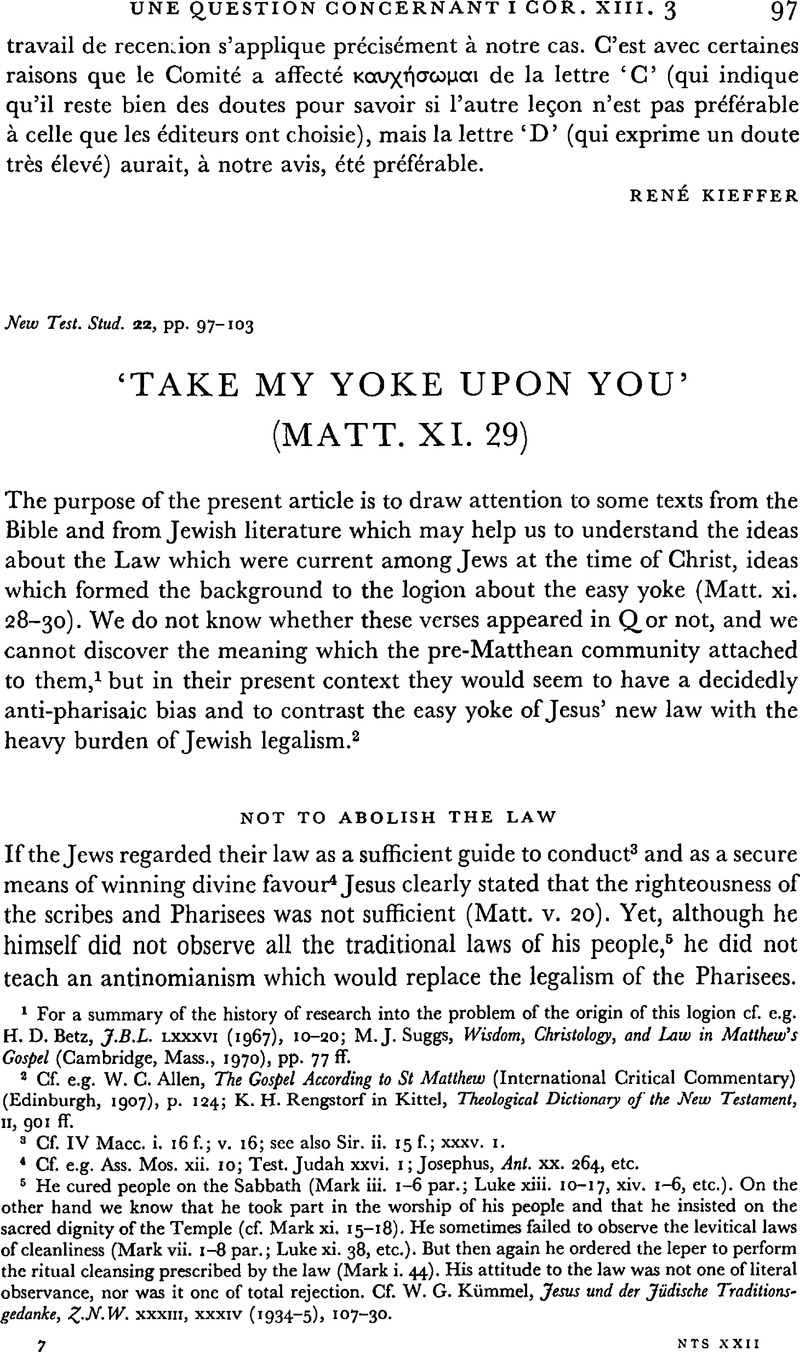Article contents
‘Take my yoke upon you’ (Matt. xi. 29)
Published online by Cambridge University Press: 05 February 2009
Abstract

- Type
- Short Studies
- Information
- Copyright
- Copyright © Cambridge University Press 1975
References
page 97 note 1 For the summary of the history of research into the problem of the origin of this logion CfBetz, H. D., J.B.L. LXXXVI (1967), 10–20;Google ScholarSuggs, M. J., Wisdom, Christology, and law in Matthew–s Gospel (Cambridge, Mass., 1970), pp. 77 ff.CrossRefGoogle Scholar
page 97 note 2 CfAllen, W. C., The Gospel According to St Matthew (International Critical Commentary) (Edinburgh, 1907), p. 124; K. H. Rengstorf in Kittel, Theological Dictionary of the New Testament, 11, 901 ff.Google Scholar
page 97 note 3 Cf. IV Mace. i. 16 f.; V. 16; see also Sir. ii. 15 f; xxxv. 1.
page 97 note 4 Cf e.g. Ass. Mos. xii. 10; Test. Judah xxvi. 1; Josephus, Ant. xx. 264, etc.
page 97 note 5 He cured people on the Sabbath (Mark iii. 1–6 par.; Luke xiii. 10–17, xiv. 1–6, etc.). On the other hand we know that he took part in the worship of his people and that he insisted on the sacred dignity of the Temple (cf. Mark xi. 15–18). He sometimes failed to observe the levitical laws of cleanliness (Mark vii. 1–8 par.; Luke xi. 38, etc.). But then again he ordered the leper to perform the ritual cleansing prescribed by the law (Mark i. 44). His attitude to the law was not one of literal observance, nor was it one of total rejection. CfKümmel, W. G., Jesus und der Jüdische Traditions-gedanke, Z.N.W. XXXIII, XXXIV (1934–5), 107–30.Google Scholar
page 98 note 1 Some authors remark that Matt. xi. 25–30 seems to depend on Sir. li; cfMontefiore, C. G., The Synoptic Gospels (London, 1909), 11, 606–9.Google Scholar
page 99 note 1 ‘The yoke of the Torah:’ Pirke Aboth, iii. 5; b Sanhedrin 94b; Gen. R. 67. 7; ‘the yoke of heaven:’ b Sotah 47b; b Sanhedrin 111b; ‘the yoke of the commandments:’ M. Berakoth ii. 2. For further references to the ‘yoke’ see Billerbeck, H. L. Strack-P., Kommentar zum Neuen Testament aus Talmud und Midrash (Munich, 3rd ed. 1933), 1, 608–10;Google ScholarAbrahams, I., Studies in Pharisaism and the Gospels, second series (Cambridge, 1924), pp. 4–14;Google ScholarBüchler, A., Studies in Sin and Atonement in the Rabbinic Literature of the First Century (Oxford, 1928), pp. 52 ff.Google Scholar
page 99 note 2 Cf. e.g. Josephus, Contra Apionem, 11. 164–71; Exod. R. xxx. 6. Indeed it was believed that without law and order as exemplified by the Torah the world would lapse into chaos; cf. b Shabbath. 88 a.
page 100 note 1 Cf. Pseudo-Philo, Liber Antiquitatum Biblicarum, xvi. 1; Targum Pseudo-Jonathan on Num. xvi. 2.
page 100 note 2 Pirke Aboth, i. 1. The comparison of rabbinical law with a fence seems to have been common. Eccl. X. 8 (who breaketh through the fence a serpent shall bite him) was applied to punishment for transgressions against rabbinical laws, and this application gave rise to the phrase ‘the serpent of the rabbis has bitten him’; cf. e.g. Eccl. R. x. 8 and see Chaim Rabin, Qumran Studies, Oxford Studies (1957). P. 96.
page 100 note 3 Cf. Mekilta on Exod. xx. 2, Lauterbach, J. Z., Mekilla de-Rabbi Ishmael (Philadelphia, 1933), n, 234 f.; b Abodah Zarah 2b; Exod. R. v. 9, etc.Google Scholar
page 100 note 4 See the Targumim on Deut. xxvii. 8; b Shabbath 88 b.
Mekilta on Exod. xx. 2, Lauterbach, op. cit. 11, 229 f.
page 102 note 1 CfMoore, George Foot, Judaism in the First Centuries of the Christian Era (Cambridge, Mass.), 11, 223 ff.; the idea that ‘It matters not whether you do much or little so long as your heart is directed to heaven’ (b Berakoth, 17a) occurs again and again in Rabbinic literature; seeGoogle ScholarMontefiore, C. G. and Loewe, H., A Rabbinic Anthology (Philadelphia, 1963), 7–3, pp. 272 ff.Google Scholar
- 2
- Cited by




